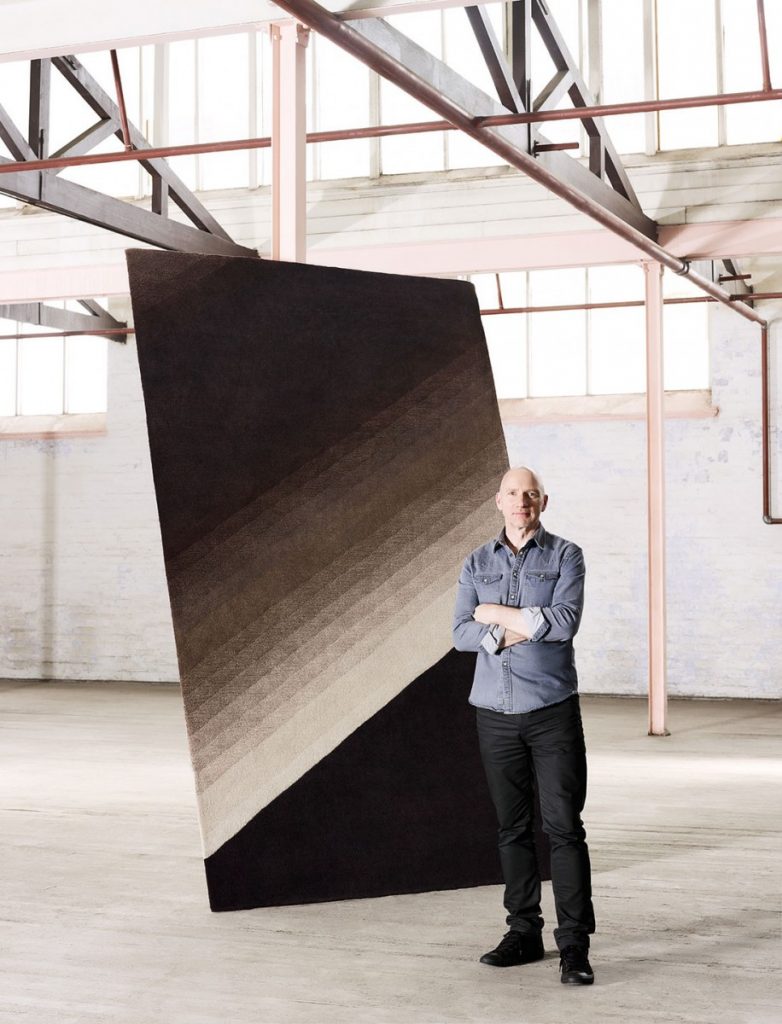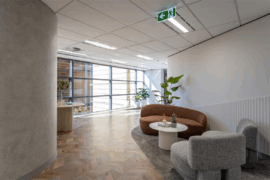Having just launched their inaugural rug collection, Stylecraft reminds us that Australians continue to reimagine the design rulebook.
Since even before the Classical Period, the humble rug has remained a perennial subject of poetry and mythmaking. Capturing the imagination of designers across the millennia, rug design continues to evolve alongside the shifting landscapes of many sectors – from the smaller scale residential approach, right through to mammoth statement pieces currently enjoying a renaissance in commercial and hospitality environments. Equaling the prestige and quality of fibres one expects to see on haute couture runways, contemporary rug design has embraced the most luxuriant materials while also remaining abreast of landmark technological developments in textile design and manufacture. And, within this space, Australia is beginning to leave an indelible mark on design history.
Thanks to one of Australia’s most-active brands, Stylecraft, many of our A+D community’s biggest names have turned their hands to the art of rug design. Kickstarting 2018 with Stylecraft‘s inaugural range of rugs by Australian design heavyweights – including Ross Gardam, Alexander Lotersztain, Keith Melbourne, Tom Skeehan and Helen Kontouris – the brand welcomes this new product typology to an already comprehensive design portfolio. Designed chiefly in Australia, and handcrafted in India through TAPPETI Rugs, this handmade collection uses natural fibres including New Zealand’s coveted wool. Across all processes – from dying of yarn, tufting, binding and finishing – each piece carries an individual flair that can only be achieved through a constant commitment to the expertise of rug artisans.
As exciting and varied as the Australian landscape itself, the new range of rugs explores composition, texture, shape, and colour. Alexander Lotersztain and Helen Kontouris celebrate topography from above with their respective rugs, ‘Salt Plains’ and ‘Terraces’. Lotersztain drew inspiration from the transition from “the iconic red centre with endless sand dunes and stunning salt lake colours to open skies that meet the aqua waters”, tinting his rugs in vibrant, saturated hues.
“Salt Plain represents the iconic red centre with endless sand dunes and stunning salt lake colours, to open skies that meet the aqua waters. The rich colours of this harsh and beautiful land inspired the geometrical forms and natural hues.” – Alexander Lotersztain.

Meanwhile, Kontouris emphasizes organic patterns and the dazzling organic and geometric sophistications we find within Asia’s stepped rice terraces. So in keeping with Kontouris’ evolving biophilic aesthetic, ‘Terraces’ balances the delicate interplay of softened geometry and hardened organic forms we encounter in nature. What is especially remarkable is the manner in which Kontouris plays with vantage and scale – here the rug winkingly hints at the topography of stepped rice fields from a bird’s eye perspective, re-performing this interplay in the topography of the rug’s various segments.
“There is nothing more beautiful, inspiring and grounding than nature in all its forms. Many of my creative ideas take reference from nature’s striking intelligence and simplicity, the structure of a delicate leaf or the elegance of an entwined vine dancing along a terrace. My passion is to bring this natural beauty and all its benefits within the spaces where we create, live and play.” – Helen Kontouris (interviewed in Ignant).

Taking a subtle, linear approach are Ross Gardam and Keith Melbourne, whose rugs deftly abstract line and tone. Gardam’s ‘Noon’ is the collection’s only circular rug, and reflects through gradual tonal changes the passage of light during a 24-hour period. ‘Noon’ coordinates with Gardam’s recent furniture collection of the same name, which is also available in Australia through Stylecraft.
“I think there is a cohesive design language that has developed pretty naturally throughout my practice. Working across a variety of materials and process is challenging however a desire to continue to refine or take objects to a certain place has shaped new and surprising connections between the products even if this link is not always an aesthetic one.” – Ross Gardam (interviewed in IndesignLive).

In a similar vein, Melbourne’s ‘Wash’ also focuses on the play of light in the built environment. An elegant gradient of seven tonal colours evokes Melbourne’s idiosyncratically sleek and precise design aesthetic, embodying the nuanced minimalism of contemporary residential design. In particular, ‘Wash’ emerges as an exercise in restraint and balance – here consciously moderate controlled, there effectively accentuated and over-emphasised – the piece re-enacts the dynamism of light by which it’s inspired.
“Wash draws inspiration from the play of light within sculptural architecture. Sharp gradients of tonal colour reflect the precision and clean aesthetic seen throughout my collection of furniture.” – Keith Melbourne.

Tom Skeehan’s ‘Hoshi’ rug also picks up on this thread of minimalist dreaming, drawing inspiration from a restrained, sophisticated Japanese design legacy. A unique arched shape and bold geometric emphasis combine to create an inimitable feature piece that is as timeless as it is striking. As the latest addition to Skeehan’s Hoshi Collection, the Hoshi Rug joins a portfolio of armchairs, kounges, side tables, bench seats, ottomans and a coat stand, all emphasising the subtle articulations of negative space between the range’s various compositional elements.
“I have personally experienced Japan’s deep attraction to materials and process, combined with a rich understanding of how an object is made and the purpose / life cycle of the work […]. Aesthetically, I admire the restraint and often minimal approach to many aspects of Japanese culture, placing a strong emphasis on the overall process and individual daily ritual.” – Tom Skeehan (interviewed in The Design Writer).

The release of the rugs is a reminder of Stylecraft‘s commitment to nurturing Australian talent and bringing it to as diverse an audience as possible. Since its establishment in Melbourne over sixty years ago, Stylecraft has consistently shone the limelight on upcoming Australian designers, celebrating their unique style and innovative thinking. Stylecraft is an advocate of encouraging the multiplicity of voices and viewpoints that so colours Australia’s approach to design, and to this end is recognising the importance of supporting our local communities.
In conjunction with the launch of the new rug collection, Stylecraft is proud to announce their partnership with Australian organisation, Tjanpi Desert Weavers (TDW). Based in Alice Springs, TDW enable over 400 female artists in remote central Australian deserts to earn their own income from fibre art. Committed to enabling indigenous artists to continue to be able to use their skills to create contemporary Australian design pieces, Stylecraft is donating ten per cent of each rug sale to TDW, ultimately supporting the facilitation of material supply, weaving workshops and exhibitions.




INDESIGN is on instagram
Follow @indesignlive
A searchable and comprehensive guide for specifying leading products and their suppliers
Keep up to date with the latest and greatest from our industry BFF's!

For those who appreciate form as much as function, Gaggenau’s latest induction innovation delivers sculpted precision and effortless flexibility, disappearing seamlessly into the surface when not in use.

The undeniable thread connecting Herman Miller and Knoll’s design legacies across the decades now finds its profound physical embodiment at MillerKnoll’s new Design Yard Archives.

For a closer look behind the creative process, watch this video interview with Sebastian Nash, where he explores the making of King Living’s textile range – from fibre choices to design intent.

London-based design duo Raw Edges have joined forces with Established & Sons and Tongue & Groove to introduce Wall to Wall – a hand-stained, “living collection” that transforms parquet flooring into a canvas of colour, pattern, and possibility.

A thoughtful, low-waste redesign by PMG Group in collaboration with Goodman has transformed a dated office into a calm, contemporary workspace featuring a coastal-inspired palette and Milliken flooring for a refined finish.

Tappeti’s latest rugs have been unveiled at one of Luigi Rosselli’s stunning Sydney coastal homes alongside furniture by Design Nation.
The internet never sleeps! Here's the stuff you might have missed

Australia’s first planted light rail corridor sets new benchmark for transport-led urban transformation.

Rising above the new Sydney Metro Gadigal Station on Pitt Street, Investa’s Parkline Place is redefining the office property aesthetic.